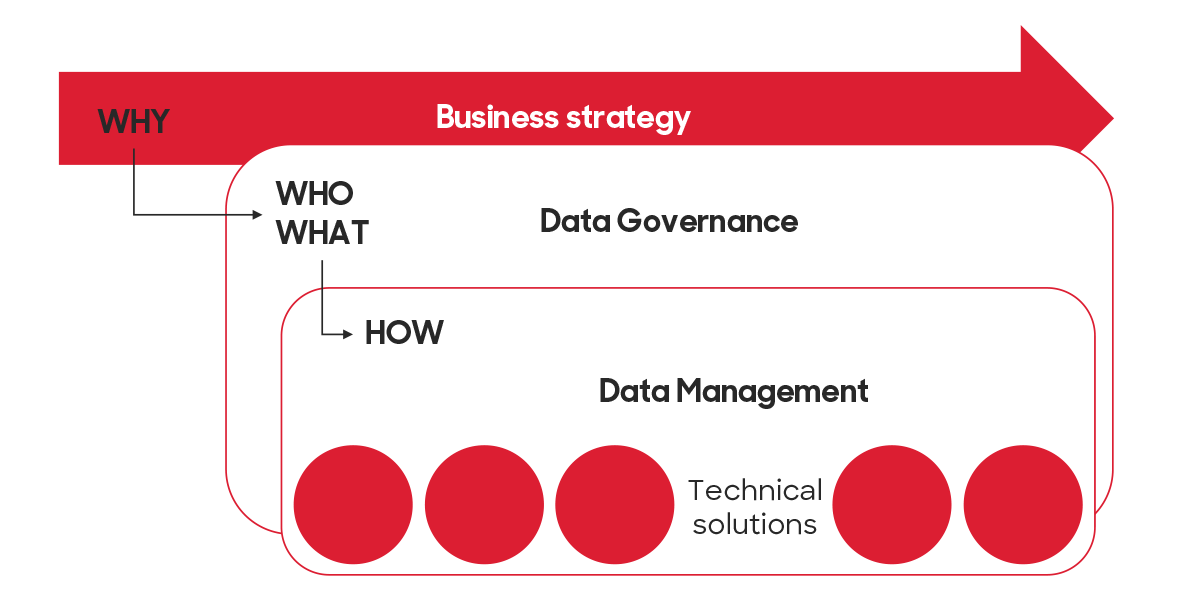We all know today’s organisations, both public and private, can collect and maintain huge amounts of complex data. Data has become an important, if not the most important, asset of the modern organisation. A data-driven organisation realises the value of data and utilises it in decision making and other critical business processes. To make data valuable and, above all, useful, discipline is needed. Data, like other assets, needs to be governed in terms of acquisition, maintenance, (re-)use, disposal, roles, responsibilities, and economics, for example.
What is data governance, and more importantly, what is it not?
To develop and implement Data Governance in any meaningful way, we should first try to understand it in a simple enough way. The functions of Data Governance and Data Management are intermingled but they can also be seen to represent two different parts of key activities critical for any organisation on a path to a data-driven one:
- The actual management and utilisation of the data assets (the ‘HOW‘ part)
- The governance of goals, tasks, responsibilities, operations, and resources (the ‘WHAT, WHY, and WHO‘ part) required to utilise the data assets of an organisation in a cost-efficient and sustainable way
The ‘HOW‘ part, which for simplicity we can call ’Data Management’, should be understood as the daily operations and activities including the technological solutions required to manage and utilise the data and provide interoperability.
The ‘WHAT, WHY and WHO‘ part, or in this case ‘Data Governance‘, connects the actual business goals and strategy of an organisation (‘WHAT, WHY’) with defined tasks and responsibilities (‘WHO’), thus giving us an insight on the critical data-driven leadership, decision-making and steering processes of an organisation, not just the rather narrow view of Data Management through a set of technical solutions.
Data governance – not dada governance
Data Governance is both the application of common Data Management principles across the enterprise and making sure those operations are properly resourced, led, and most importantly connected to the business goals of an organisation. Without leadership, coordination and a clear connection to the business objectives, development, and IT, Data Governance becomes meaningless. If we interpret and implement Data Governance as simply a set of technical solutions to manage the data, we are straying from the path of becoming data-driven and staying in silos.
Being data-driven is not just a series of technical developments and solutions, it is mostly about organisational development and making sure the different parts of a whole, or stakeholders if you will, work together in a coordinated way. Thus, the actual question of governing your data, or Data Governance, is how to organise or rather govern the respective intermingled activities (business development, IT, data architecture, etc.) related to data.
The path toward a data-driven organisation
The main goal of Data Governance in any organisation should be the efficient and secure utilisation of data assets in business processes at the enterprise level. This requires both technical and non-technical expertise and above all clearly defined goals and roles and communication between key personnel. In other words, leadership and a management system are critical for efficient and successful governance.
Data Governance must first and foremost be a business development issue, not a technical one. A data-driven business strategy and the resulting coordinated collaboration (or perhaps a phased governance model) to implement it is a good start. It is not necessary to get everything planned and right all at once but to move incrementally step by step towards the defined business goals.
Based on our experience, business development and organisational development are generally easier if one understands the operational environment and the roles and responsibilities that go with it. Coordination, leadership, participation of stakeholders and clear business goals tend to help.
Want to learn more? Watch the recording of the event Solita Talks – Why will digitalization fail without data governance?



